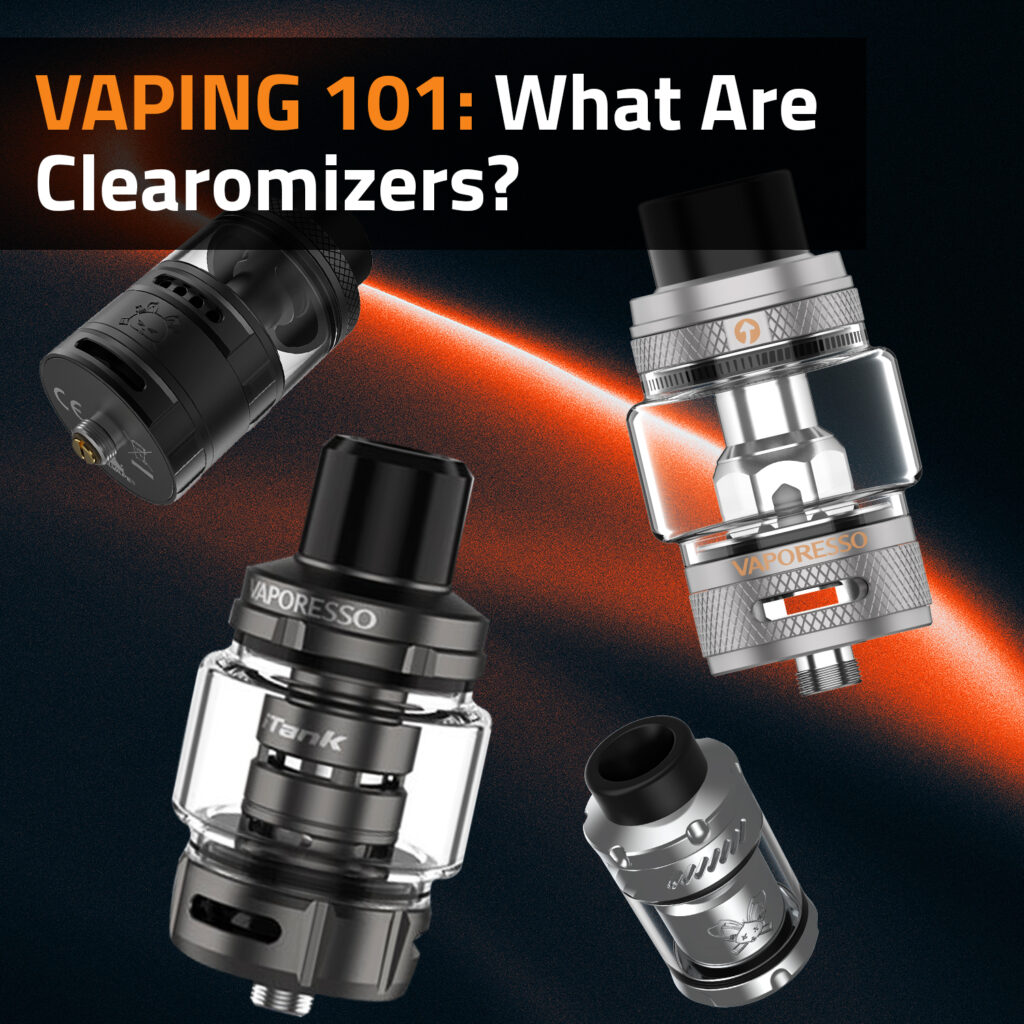Whether you are new to vaping or an experienced vaper upgrading your kit, understanding the components of your device is key to a satisfying experience. Among the most essential parts of any e-cigarette or vape kit is the clearomizer – a versatile, transparent atomizer tank that plays a central role in transforming e-liquid into vapour.
In this guide, we will dive into everything you need to know about clearomizers: what they are, how they work, their evolution, the types available, how to use them properly, and tips for choosing the right one for your needs.
What Is A Clearomizer?
At its core, a clearomizer is a type of atomizer with a transparent (or semi-transparent) tank that holds e-liquid and a pre-built, replaceable coil. The term “clearomizer” combines “clear” and “atomizer”, emphasising the visible tank feature that allows users to monitor e-liquid levels easily.
The clearomizer attaches to the battery or mod portion of a vape and is responsible for heating the e-liquid into vapour. This makes it arguably the most important part of your device, since it is where the flavour, vapour, and overall vaping experience come together.
How It Works
A clearomizer consists of:
- A transparent tank that holds e-liquid (usually made of plastic or glass)
- A coil head, which contains a heating element (usually a wire coil and a cotton wick)
- A base that connects to the battery
- An airflow system, allowing air to pass through the tank
- A drip tip (mouthpiece) for inhaling vapour
When the device is activated, the battery sends power to the coil, which heats up and vaporises the e-liquid soaked in the wick. The user then inhales the vapour through the drip tip.
Clearomizers Vs. Other Atomizers
There are three main types of atomizers in vaping:
- Clearomizers – Pre-built coils, user-friendly, transparent tanks
- Cartomizers – Older style, filled with e-liquid-soaked polyfill, limited use today
- Rebuildable atomizers (RBAs, RDAs, RTAs) – Require manual coil building, best for advanced users
Clearomizers stand out for their simplicity and convenience, making them ideal for beginners or vapers who do not want to deal with coil building or complex maintenance.
The Evolution Of The Clearomizer
Clearomizers have undergone significant changes over the years in order to provide a variety of options for any vaper.
2012: The CE4 Stardust
The first mass-market clearomizer to gain traction was the CE4, also known as the Stardust, introduced by Joyetech. It featured a transparent tank, fixed coils, and a top-fill design. While revolutionary for its time, the CE4 had issues like leaking and inconsistent coil performance. It quickly became obsolete as technology improved.
2013: Aspire’s Nautilus Changes the Game
Aspire made history with the launch of the Nautilus and Nautilus Mini, which brought improved coil technology and adjustable airflow to the clearomizer category. These tanks offered better flavour, reliability, and were a favourite among vapers seeking mouth-to-lung (MTL) hits that resembled smoking.
2015: Sub-Ohm Clearomizers Go Mainstream
Kanger’s Subtank Mini made sub-ohm vaping (coils under 1.0 ohm) more accessible to the average user. It introduced replaceable sub-ohm coils and a larger tank, supporting direct-to-lung (DTL) vaping and cloud production. It marked the start of a new era where performance met simplicity.
Today’s clearomizers benefit from years of innovation. Modern models are:
- Easy to use
- Leak-resistant
- Designed for both MTL and DTL
- Equipped with improved coil materials and airflow systems
Clearomizer Design And Filling Mechanisms
Clearomizers typically hold between 1 to 5 ml of e-liquid, depending on the model. Given that the average user consumes around 3 – 4 ml of e-liquid daily, most clearomizers can easily last through a full day.
Top-Fill Vs. Bottom-Fill
- Top-fill clearomizers allow users to refill e-liquid by unscrewing the top cap – convenient and mess-free.
- Bottom-fill models require detaching the tank from the base to refill, which can be slightly more time-consuming but still manageable.
- Modern clearomizers often include sliding tops, push-button fill ports, or twist-open mechanisms, making the process more hygienic and straightforward.
Tip: Never pour e-liquid into the central air tube (chimney). This can flood the coil and cause gurgling or leaking. Always fill down the side of the tank.
How to Use a Clearomizer Correctly
Using a clearomizer is relatively simple, but there are some key practices to follow to ensure optimal performance and longevity.
1. Prime Your Coil
Before your first use (or after replacing the coil), allow the wick to become fully saturated with e-liquid. This avoids dry hits – a burnt taste caused by vaping a dry coil.
How To Prime A Coil:
- Drop a few drops of e-liquid directly onto the cotton inside the coil
- Fill the tank and wait 5–10 minutes before vaping
2. Choose The Right Power Setting
Make sure your device’s wattage matches the recommended range for your coil. Most coil heads have the ideal wattage engraved on them. Using too much power can burn the coil; too little may cause poor vapour production.
3. Replace Coils Regularly
Coils do not last forever. On average, a clearomizer coil will last 1 to 2 weeks, depending on usage, e-liquid type, and device power. Signs you need a new coil include:
- Burnt or unpleasant taste
- Reduced vapour output
- Gurgling or leaking
Types Of Clearomizers: MTL Vs. DTL
Clearomizers come in two primary configurations, depending on how you inhale the vapour.
Mouth-To-Lung (MTL)
- Mimics smoking a traditional cigarette
- Vapour is first drawn into the mouth, then inhaled into the lungs
- Narrow mouthpieces and tighter airflow
- Best with higher-resistance coils (1.0 ohm or more)
- Suitable for nicotine salts or higher-nicotine freebase e-liquids
Direct-To-Lung (DTL)
- Inhale vapour straight into the lungs
- Produces large clouds and intense flavour
- Wider airflow and drip tips
- Uses sub-ohm coils (below 1.0 ohm)
- Best with low-nicotine e-liquids and higher VG content
Choosing the right style depends on your personal preference, nicotine needs, and the kind of vape experience you’re looking for.
Clearomizers And Open Systems
One of the biggest benefits of clearomizers is their compatibility within open vaping systems. These setups allow users to pair different clearomizers with different mods or batteries, thanks to standard 510 threading.
This flexibility means you can upgrade or change your setup without being locked into one brand or model.
What To Look For When Choosing A Clearomizer
When shopping for a clearomizer, consider the following factors:
- Build quality: Look for brands known for durability, leak-proof designs, and stainless steel or Pyrex glass construction.
- Tank capacity: A larger tank (3–5 ml) reduces the need for frequent refilling, especially for DTL vapers.
- Coil compatibility: Check what types of coils are available – are they easy to find? Do they support the vaping style you prefer?
- Airflow control: Adjustable airflow lets you fine-tune the resistance and vapour production to your liking.
- Ease of use: Choose top-fill designs, plug-and-play coils, and user-friendly features for convenience.
For most beginner and intermediate vapers, clearomizers offer the perfect balance of ease-of-use, versatility, and performance. Whether you are a former smoker seeking a smooth mouth-to-lung experience or a cloud chaser interested in direct-to-lung hits, there is a clearomizer designed to meet your needs.
As vaping technology continues to evolve, clearomizers remain at the forefront – offering powerful features without overwhelming complexity. Just remember to prime your coils, use the right wattage, and refill properly to enjoy the best that modern vaping has to offer.





